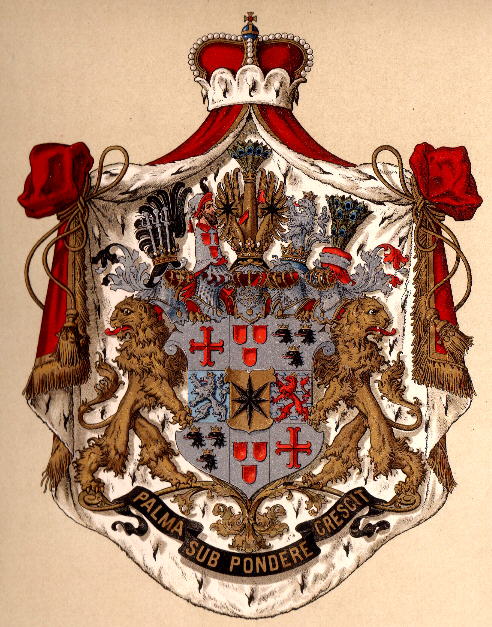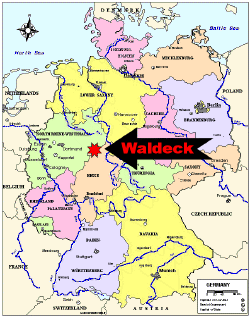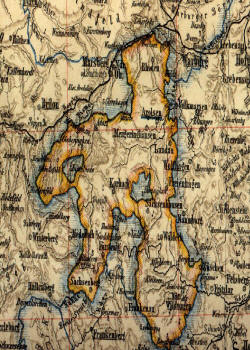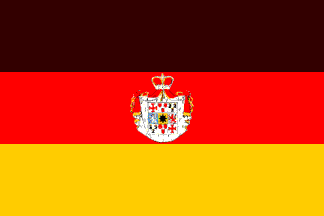|
The Principality of Waldeck, Germany |
|
 The Crest of the Prince of of
Waldeck
The Crest of the Prince of of
Waldeck
|
|
Standard of the Prince until c.1897
|
Standard of the Prince c.1897-c.1900
|
Standard of the Prince c.1900-1918
|
|
 Modern Germany
Modern Germany
|
 The Principality of Waldeck
The Principality of Waldeck
|
 The German Empire
before 1918
The German Empire
before 1918
|
 Enlargement of
Weldeck Area
( Weldeck is in green at
upper left corner)
Enlargement of
Weldeck Area
( Weldeck is in green at
upper left corner)
|
Waldeck (väl´dĕk) , former principality, central Germany, now an administrative district (c.420 sq mi/1,090 sq km) of Hesse. Arolsen was the capital. An agricultural region, hilly and forested, it is drained by the Eder and Diemel rivers. A county of the Holy Roman Empire from c.1200, Waldeck was united with the county of Pyrmont in the late 17th cent., and its rulers were later raised (1712) to princely rank. In 1867 the prince of Waldeck-Pyrmont renounced most of his sovereign prerogatives in favor of Prussia; the title, however, continued in the family. Waldeck-Pyrmont became a republic in 1918. By a plebiscite in 1922, Pyrmont passed to Prussia and was incorporated into Hanover prov.; by another plebiscite (1929) Waldeck proper became part of the Hesse-Nassau prov. of Prussia. After World War II it was made part of Hesse. Taken from: The Columbia Encyclopedia, Sixth Edition. Copyright © 2003 Columbia University Press |
|
| WALDECK-PYRMONT, a principality of
Germany and a constituent state of the German empire, consisting of two
separate portions lying about 30 m. apart, viz. the county of Waldeck,
embedded in Prussian territory between the provinces of Westphalia and
Hesse-Nassau, and the principality of Pyr-mont, farther to the north,
between Lippe, Brunswick, Westphalia and Hanover. Waldeck comprises an
area of 407 sq. m., covered for the most part with hills, which culminate
in the Hegekopf (2775 ft.). The centre is occupied by the plateau of
Corbach. The chief rivers are the Eder and the Diemel, both of which
eventually find their way into the Weser. Pyrmont, only 26 sq. m. in
extent, is also mountainous. The Emmer, also belonging to the Weser
system, is its chief stream. The united area is thus 433 sq. m., or about
half the size of Cambridgeshire in England, and the united population in
1905 was 59,127, showing a density of 138 to the square mile. The
population is almost wholly Protestant. In consequence of the
comparatively high elevation of the countrythe lowest part being 540 ft.
above the sea-levelthe climate is on the whole inclement. Agriculture and
cattle-rearing are the main resources of the inhabitants in both parts of
the principality, but the soil is nowhere very fertile. Only 57% of the
area is occupied by arable land and pasture; forests, one-tenth of which
are coniferous, occupy 38%. Oats is the principal crop, but rye, potatoes
and flax are also grown in considerable quantities. Fruit is also
cultivated in the principality. Iron mines, slate and stone quarries are
worked at various points, and, with live stock, poultry, wool and timber
form the chief exports. A few insignificant manufactures are carried en in
some of the little towns, but both trade and manufactures are much
retarded by the comparative isolation of the country from railways.
Wildungen, in the extreme south of Waldeck, is the terminus of a branch
line from Wabern, and a light railway runs from Warburg to Marburg;
Pyrmont is intersected by the trunk line running from Cologne,viaPaderborn,
to Brunswick and Berlin. The capital and the residence of the prince is Arolsen (pop. 2811 in 1905) in Waldeck; twelve smaller townships and about one hundred villages are also situated in the county. The only town in Pyrmont is Bad Pyrmont, with about 1500 inhabitants, a highly fashionable watering-place with chalybeate and saline springs. The annual number of visitors is about 23,000. Wildungen is also a spa of repute. The inhabitants to the north of the Eder are of Saxon stock, to the south of Franconian, a difference which is distinctly marked in dialect, costumes and manners. Waldeck-Pyrmont has one vote in the federal council (Bundesrat) and one in the Reichstag. The constitution, dating from 1852, is a reactionary modification of one carried in 1849, which had been a considerable advance upon one granted in 1816. The Landtag of one chamber consists of fifteen members, three of whom represent Prymont, elected indirectly for three years. In the event of the male line of the present ruling family becoming extinct, the female line will succeed in Waldeck, but Pyrmont will fall to Prussia. In terms of a treaty concluded in 1867 for ten years, renewed in 1877 for a similar period, and continued in 1887 with the proviso that it should be terminable on two years' notice, the finances and the entire government of Waldeck-Pyrmont are managed by Prussia, the little country having found itself unable to support unassisted the military and other burdens involved by its share in the North German Confederation of 1867-1871 and subsequently as a constituent state of the German empire. The government is conducted in the name of the prince by a Prussian WALDECK-ROUSSEAU " Landesdirector," while the state officials take the oath of allegiance to the king of Prussia. The prince of Waldeck reserves his whole rights as head of the church, and also the right of granting pardons, and in certain circumstances may exercise a veto on proposals to alter or enact laws. Education and similar matters are thus all conducted on the Prussian model; a previous convention had already handed over military affairs to Prussia. The budget for 1910 showed a revenue of 57,000 and a like expenditure. The public debt was 79,710, paying interest at 35%. The prince is supported by the income derived from crown lands. As regards the administration of justice, Waldeck and Pyrmont belong to the districts of Cassel and Hanover respectively. The princes of Waldeck-Pyrmont are descendants of the counts of Schwalenberg, the earliest of whom known to history was one Widukind (d. 1137). His son Volkwin (d. 1178) acquired by marriage the county of Waldeck, and his line was divided into two branches, Waldeck and Landau, in 1397. In 1438 the landgrave of Hesse obtained rights of suzerainty over Waldeck, and the claims arising from this action were not finally disposed of until 1847, when it was decided that the rights of Hesse over Waldeck had ceased with the dissolution of the Holy Roman Empire. The Landau branch of the family became extinct in 1495, and in J63i Waldeck inherited the county of Pyrmont, which had originally belonged to a branch of the Schwalenberg family. For a few years Waldeck was divided into Wildungen and Eisenberg, but in 1692, when the Wildungen branch died out with George Frederick, the imperial field-marshal, the whole principality was united under the rule of Christian Louis of Eisenberg. From 1692 the land has been undivided with the exception of a brief period from 1805 to 1812, when Waldeck and Pyrmont were ruled by two brothers. Frederick Anthony Ulrich (d. 1728), who succeeded his father, Christian Louis, in 1706, was made a prince of the empire in 1712. In 1807 Waldeck joined the confederation of the Rhine, and in 1815 entered the German confederation. Its first constitution was granted in 1816 by Prince George II. (d. 1845). Prince Frederick (b. 1865) succeeded his father, George Victor (1831-1893), as ruler on the 12th of May 1893. The most important fact in the recent history of the principality is its connection with Prussia, to which reference has already been made. See Curtze, Geschichte und Beschreibung des Fiirstentums Wnldeck (Aroisen, 1850); Lowe, Heimatskunde van Waldeck (Arolsen, 1887); J. C. C. HOffmeister, Historisch-genealogisches Handbuch uber alle Graven und Fiirsten van Waldeck seit 1228 (Cassel, 1883); Bottcher, Das Staatsrecht des Fiirstentums Waldeck (Freiburg, 1884); A. Wagner, Die Geschichte Waldecks und Pyrmonts (Wildungen, 1888), and the Geschichtsblatterfiir Waldeck und Pyrmont (Mengeringhausen, 1901, fol.). Taken from "WALDECK-PYRMONT." LoveToKnow 1911 Online Encyclopedia. © 2003, 2004 LoveToKnow.http://30.1911encyclopedia.org/W/WA/WALDECK_PYRMONT.htm |
|
| Back to the Swartzentrover line | |


